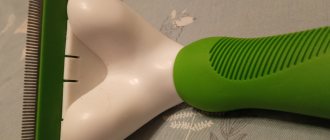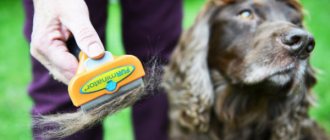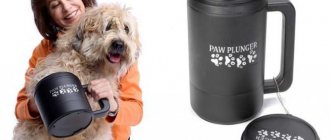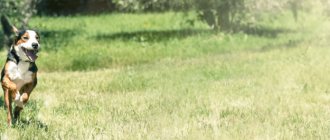Any walk with the dog ends with washing its paws and belly. Many owners have a whole arsenal of various rags and brushes, which they have adapted to effectively clean the animal’s paws from street dirt. Not long ago, an interesting device appeared in online pet supply stores, and then in regular ones - the paw plunger. This is a special paw washer, made in the form of a glass with a built-in brush. From the article you will learn: how to choose the right container, where you can buy it, how to use it and how to make it yourself.
What does a dog paw wash look like?
A device for daily hygiene of the paws of four-legged pets is a plastic container made in the form of a glass, on the neck of which a silicone nozzle with antennae is attached. Water and shampoo, liquid soap or other cleaning and disinfecting composition are added to the container itself. In addition to the shape of a glass, the paw wash can be made in the form of a box, have one or two handles and other modifications. The devices differ depending on the size of the dog whose paws they are intended to wash.
Main parts of the paw washing device:
- container for cleaning liquid: glass, box, small bucket with or without handles;
- a cover-nozzle with a hole for the paw, inside of which there are silicone antennae. They can be built directly into the walls of the glass. Users note that this is not a very convenient container, since it is necessary to be able to clean the structure itself.
Is it possible to make a paw wash yourself?
Devices of this type are, as already mentioned, quite expensive. However, their design is relatively simple. Therefore, if you want to make a paw washer for your four-legged friend, you can do it yourself. The easiest way to make such an accessory is from a large plastic glass, choosing a lid of the appropriate diameter for the latter. If desired, the resulting homemade paw wash can be supplemented with small soft brushes intended for washing dishes. They just need to be secured to the walls inside the glass.
How does a paw washer work?
To clean your paws from street dirt, you need to follow a series of steps:
- Pour the required volume of clean warm water through the top hole. It must be taken into account that with the forward movement of the paws, water may splash onto the floor. Typically, the manufacturer marks the container with a strip indicating a safe level. You can add a few drops of shampoo, disinfectant solution or essential oil to the water;
- calm the dog down, take one of its paws and put it in a glass. Cleansing is performed with progressive movements up and down. Another option is rotational movements of the paw inside the glass;
- Remove the dog's limb from the paw wash. Usually the antennae remove excess moisture from the dog’s paws, but the owner can additionally wipe them with a dry cloth. It is worth choosing microfiber - it will effectively remove excess moisture and additionally clean the pads.
It is not worth changing the water in the paw wash separately for each limb, since you will have to leave the dog and perform manipulations to replace the fluid. The main thing in the operation of the device is mechanical cleaning using silicone antennae. You should start with the cleanest paw; the dirtiest paw should be given a little more time. At the end of the procedure, wash the container and dry it well.
You can store it with other grooming equipment, but it is better to choose a place that will not allow the dog to get to it.
If chewed, the plastic edges of the paw wash can injure the animal, and the silicone antennae can clog the esophagus if swallowed.
Which devices do pet owners think have disadvantages?
The paw washing device, according to dog breeders, is therefore quite convenient. However, this device also has certain disadvantages. These include, first of all, the difficulty of training the animal itself. Many dogs are extremely reluctant to wash their paws even in a basin or in the bathtub. According to some animal lovers, it is almost impossible to accustom them to paw washing.
Also, judging by the reviews available on the Internet, the disadvantages of such accessories for dogs include their fairly high cost. Despite the fact that paw washers are not structurally complex, and most often not so many materials are used on them, they are quite expensive.
Dog owners consider another disadvantage of this type of device to be the inability to control the condition of their animals’ paws. When washing by hand, all injuries, calluses, etc. on the pads and “fingers” are clearly visible. Using a paw wash, the owner may not know in time that the dog has any problems.
Also, judging by the reviews, the disadvantage of such devices is that when using them it is impossible to wash away all the dirt between the dog’s toes. This is especially true for long-haired animals. After using the paw wash, the owners of such a dog have to additionally carry it to the bath.
Types of paw washers for dogs
Modern pet supply stores offer a huge number of varieties of devices for hygiene of animal paws. Let's look at the most popular ones that can be found on the open market.
Anti-scratch
The manufacturer offers an inexpensive paw washer, made in the form of a regular plastic glass, inside of which there are silicone “sticks”. There are three sizes available: S, M, L. The device is suitable for dogs whose weight ranges from 5-35 kg. The device is easy to disassemble and clean. Just leave the clean parts of the device for a few minutes and they will dry. This will keep the paw washer clean.
Country of origin: Russia. Cost: from 500 rubles.
Paw Boss
The improved design is a whole washing complex for the pads, claws and fingers of the animal. The paw wash is made in the form of a small rectangular box with a container in the middle. Inside there are several containers connected by watercourses. The bottom of the box is lined with a special ribbed mat, which allows you to more thoroughly wash the paws and the space between the toes. Feature: it is possible to change the water to clean water without having to drain and refill the liquid. To do this, just tilt the container in a special way. Disadvantage: expensive, rarely found in stores.
Country of origin: Switzerland. Cost: from 1800 rubles.
Paw Plunger
One of the most popular paw washers for dogs in domestic stores. It has a very simple but effective design: the container itself is made in the form of a mug with a handle, additional brushes are provided inside, and a silicone lid-nozzle to protect against water splashes. The manufacturer offers three sizes, which are selected depending on the dog’s weight: up to 10 kg, from 10 to 30, and more than 30 kg. For convenience, the lid is connected to the container with a special chain.
Country of origin: USA. Cost: from 1000 (depending on size) rubles.
In addition, on the Internet you can find models with built-in massagers or electric paw washers that will do all the work for the owner. All that remains is to persuade the dog to calmly wait until the procedure is over.
What is important to know?
Whatever model of unit is chosen, it is necessary to take into account a number of points that will make hygiene comfortable:
- the model is selected based on the manufacturer’s recommendations for the dog’s weight;
- the pet’s fingers should not rest too heavily on the bottom of the container, but they should fit in it - it may be impossible to choose a magazine container for your dog due to its large size;
- It is worth paying attention to how tightly the cap-nozzle fits. If she sits loosely, you will have to constantly wipe the floor;
- The material of the product also matters. Ideally, dense plastic. It is light in weight and is not susceptible to splitting when dropped;
- a good option is a mug or box with a separate insert of silicone “tentacles”. This design can be easily disassembled and washed. In addition, you should give preference to models with additional ribbed inserts on the walls;
- When cleaning, you should be careful with dewclaws, they can be injured.
Do-it-yourself paw wash for dogs
If you don’t want to buy a product or none of those offered in stores are suitable for your pet, you can make the device yourself. For this:
- Select a container that will become the base. This could be a glass, a jar or a plastic bucket. The condition of the top edge of the container is important - it should not have chips, scratches or other damage. When using a sink, such damage can cause injury to your pet. The paw should move freely in and out of the container. Do not use glasses or jars made of breakable materials (for example, glass). During the washing process, they can break and injure both the dog and the person.
- Make a cover to prevent splashing of dirty water. It can be made of rubber, silicone cover or nylon.
- Equip the interior of the device with special cleaning antennas. You can take part of a brush, but a children's toy in the shape of a silicone hedgehog is better suited. It is necessary to attach it to the walls of the structure.
- There are no restrictions on setting up your own paw wash. The main condition is not to use materials that can cause injury. Perhaps your device will be the most effective.
Material
To make such devices, manufacturers usually use durable plastic. Judging by the reviews, paw washers for dogs break or leak quite rarely. The plastic is light weight, which makes using the device convenient. The color of the material of the device can be very different. Of course, dog owners consider black to be the most practical. But you can, of course, choose some brighter paw wash.
Devices made of transparent plastic are considered very convenient. When using such paw washers, the dog owner has the opportunity to control the cleanliness of its paws during the rinsing process.
Advantages and disadvantages
| PROS | MINUSES |
|
|
Advantages and disadvantages
The advantages include:
- portability (with a pre-prepared solution, the paw washer can be used anywhere at any time, preventing unwanted contamination in the car, at a party, in public institutions, in a hotel, etc.);
- small size and light weight of the product;
- ease of use and subsequent cleaning of the device;
- the ability to simplify the procedure for washing paws, reducing to minimal actions before, during and after the process;
- safety for the owner and pet;
- relative durability;
- wide selection of individual models;
- a large assortment on the market, as well as the opportunity to make a paw wash yourself.
Flaws:
- the pet needs to get used to the device;
- inability to properly clean the paw between the toes (important for long-haired breeds);
- minimizing contact between the owner and the pet during the washing process, which almost eliminates the possibility of a thorough examination of the condition of the animal’s skin;
- product price.
Briefly about the main thing
- A dog paw washer is a device that helps with paw hygiene after a walk.
- A container with cleaning liquid and special “antennae” saves time and leaves the floors clean.
- The dog needs to be accustomed to this type of washing.
- There are many models: from regular glasses to automatic ones.
- Most owners talk about positive experiences using the device.
Do you use similar paw washing devices? How does your dog feel about this method of hygiene? Which model did you choose and why? Please tell us about your experience using the paw washer in the comments. This will help our other readers.
Terms of use
Recommendations:
- During the warm season, it is best to use water at room temperature. In cold weather - cool, which will avoid discomfort and problems due to temperature differences.
- Do not neglect thoroughly drying your paws with a towel after procedures. This will ensure not only more thorough cleaning, but also prevention of the development of microdamages.
- When using a paw wash regularly, you should periodically inspect the condition of your pet's skin. If cracks or calluses are detected, carry out treatment without delay, and temporarily replace the use of the device with a regular high-quality wash in a bathtub or basin.











